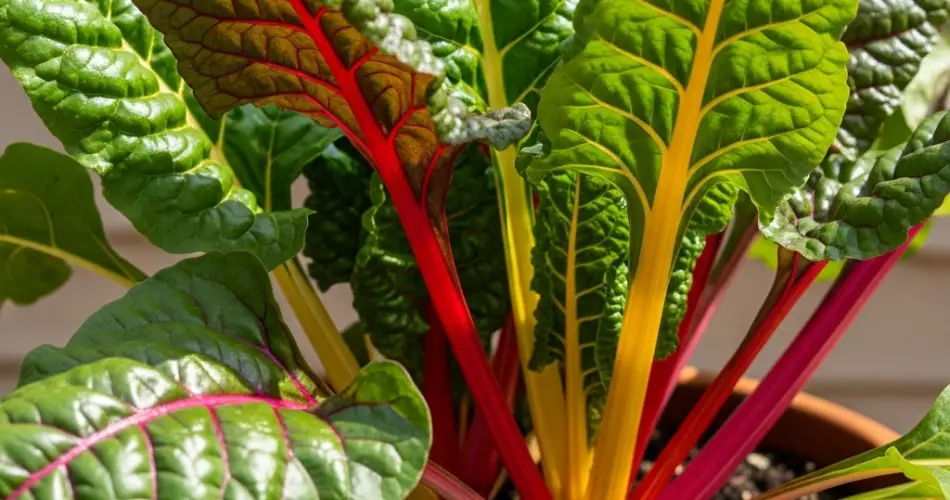Swiss chard is a vibrant, easy-to-grow leafy green that adds both color and nutrition to your garden—and your meals. Often overlooked in favor of spinach or kale, Swiss chard deserves a spot in every container garden for its rich flavor, tolerance to various conditions, and striking appearance. With colorful stems in shades of red, yellow, orange, and white, chard not only feeds you but also beautifies your space.
Whether you’re gardening on a balcony, patio, or sunny windowsill, Swiss chard thrives in pots and offers continuous harvests throughout the growing season. Here’s how to grow and enjoy this versatile green in containers.
Why Grow Swiss Chard in Pots?
Swiss chard is well-suited to container gardening for several reasons:
-
Compact and upright growth makes it ideal for small spaces.
-
Shallow roots mean it doesn’t require deep pots.
-
Long growing season allows harvests for several months.
-
Heat and cold tolerance mean it can be grown in various climates.
Unlike spinach, which bolts quickly in heat, or lettuce, which becomes bitter, Swiss chard remains productive and palatable for a long time. Its ability to regrow after harvesting makes it a great choice for home gardeners seeking a continuous supply of greens.
Choosing a Variety
Swiss chard comes in both plain green and colorful varieties. For containers, consider these popular types:
-
Bright Lights – A mix of red, pink, yellow, orange, and white stems. Adds ornamental value and flavor.
-
Fordhook Giant – Classic green variety with broad white stems. Very productive and hardy.
-
Rhubarb Chard – Deep red stems and dark green leaves, striking in appearance and mild in flavor.
All varieties perform well in pots, so your choice comes down to personal preference for color, stem size, and leaf texture.
Selecting the Right Pot
Swiss chard doesn’t require a deep container. A pot that’s at least 8–10 inches deep and wide is sufficient for one or two plants. For multiple plants, use a larger container like a rectangular planter or grow bag. Make sure the pot has drainage holes to prevent soggy soil, which can lead to root rot.
Chard also makes a good companion in mixed containers. You can pair it with herbs like basil or marigolds for added visual appeal and pest deterrence.
Soil and Fertilizer Needs
Chard prefers loose, well-draining soil enriched with organic matter. A good-quality potting mix with added compost or worm castings creates the ideal environment. Avoid heavy garden soil, which can compact and limit root growth in containers.
Feed your plants with a balanced organic fertilizer at planting time, and follow up with a nitrogen-rich liquid feed (like fish emulsion or compost tea) every 2–3 weeks. This encourages lush leaf growth and vibrant colors.
Planting and Spacing
You can sow Swiss chard seeds directly into the pot or start with transplants. If sowing seeds:
-
Plant seeds ½ inch deep and 2–3 inches apart.
-
Thin seedlings to 6–8 inches apart once they’re a few inches tall.
Spacing is important to ensure good airflow and healthy growth. Overcrowding can lead to disease or stunted plants. If using transplants, space them 6–10 inches apart from the start.
For a steady supply, sow new seeds every few weeks. This succession planting ensures you always have young, tender leaves available for harvest.
Light and Watering
Swiss chard prefers full sun but can tolerate partial shade, especially in warmer climates. Aim for at least 5–6 hours of sunlight per day. In hot regions, provide some afternoon shade to prevent wilting or leaf scorch.
Water your chard consistently to keep the soil evenly moist. Containers dry out faster than garden beds, so check the soil daily in warm weather. Avoid letting the soil dry out completely, as this can make the leaves tough and bitter.
Mulching the surface with straw, shredded leaves, or compost helps retain moisture and keeps the roots cool.
Harvesting Swiss Chard
Chard is a “cut-and-come-again” crop. Begin harvesting when leaves are 6–8 inches tall. Snip the outer leaves at the base with scissors or by hand, leaving the inner leaves to continue growing.
Regular harvesting encourages new leaf production and keeps the plant productive for several months. If you want baby leaves for salads, harvest sooner while the leaves are still tender and mild.
Avoid cutting too many leaves at once—leave at least a third of the plant intact to allow for regrowth.
Pests and Problems
Swiss chard is relatively pest-resistant, but it can attract aphids, leaf miners, and slugs. Check the underside of leaves regularly and remove pests manually. Neem oil spray or insecticidal soap can help control infestations.
To prevent fungal issues, water the soil—not the leaves—and ensure your pots are spaced for good airflow. Remove any yellowing or damaged leaves promptly.
Final Tips for Success
-
Rotate containers to promote even growth if sunlight is uneven.
-
Replenish nutrients monthly with compost or liquid feed.
-
Grow alongside herbs or edible flowers for a vibrant, productive container garden.
Swiss chard is a great addition to any home garden, offering beauty, nutrition, and versatility in a single plant. With just a pot, some soil, and a little attention, you can enjoy a rainbow of flavor at your fingertips—fresh, homegrown, and ready to harvest.



